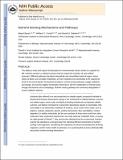| dc.contributor.author | Efeyan, Alejo | |
| dc.contributor.author | Comb, William C. | |
| dc.contributor.author | Sabatini, David | |
| dc.date.accessioned | 2015-07-21T12:27:42Z | |
| dc.date.available | 2015-07-21T12:27:42Z | |
| dc.date.issued | 2015-01 | |
| dc.date.submitted | 2014-10 | |
| dc.identifier.issn | 0028-0836 | |
| dc.identifier.issn | 1476-4687 | |
| dc.identifier.uri | http://hdl.handle.net/1721.1/97866 | |
| dc.description.abstract | The ability to sense and respond to fluctuations in environmental nutrient levels is a requisite for life. Nutrient scarcity is a selective pressure that has shaped the evolution of most cellular processes. Different pathways that detect intracellular and extracellular levels of sugars, amino acids, lipids and surrogate metabolites are integrated and coordinated at the organismal level through hormonal signals. During food abundance, nutrient-sensing pathways engage anabolism and storage, whereas scarcity triggers homeostatic mechanisms, such as the mobilization of internal stores through autophagy. Nutrient-sensing pathways are commonly deregulated in human metabolic diseases. | en_US |
| dc.description.sponsorship | National Institutes of Health (U.S.) (Grant R01 CA129105) | en_US |
| dc.description.sponsorship | National Institutes of Health (U.S.) (Grant R01 CA103866) | en_US |
| dc.description.sponsorship | National Institutes of Health (U.S.) (Grant R01 AI047389) | en_US |
| dc.description.sponsorship | National Institutes of Health (U.S.) (Grant R21 AG042876) | en_US |
| dc.description.sponsorship | American Federation for Aging Research | en_US |
| dc.description.sponsorship | Starr Foundation | en_US |
| dc.description.sponsorship | David H. Koch Institute for Integrative Cancer Research at MIT (Frontier Research Program) | en_US |
| dc.description.sponsorship | Ellison Medical Foundation | en_US |
| dc.description.sponsorship | Charles A. King Trust | en_US |
| dc.description.sponsorship | American Cancer Society (Ellison Medical Foundation Postdoctoral Fellowship PF-13-356-01-TBE) | en_US |
| dc.language.iso | en_US | |
| dc.publisher | Nature Publishing Group | en_US |
| dc.relation.isversionof | http://dx.doi.org/10.1038/nature14190 | en_US |
| dc.rights | Creative Commons Attribution-Noncommercial-Share Alike | en_US |
| dc.rights.uri | http://creativecommons.org/licenses/by-nc-sa/4.0/ | en_US |
| dc.source | PMC | en_US |
| dc.title | Nutrient-sensing mechanisms and pathways | en_US |
| dc.type | Article | en_US |
| dc.identifier.citation | Efeyan, Alejo, William C. Comb, and David M. Sabatini. “Nutrient-Sensing Mechanisms and Pathways.” Nature 517, no. 7534 (January 14, 2015): 302–10. | en_US |
| dc.contributor.department | Massachusetts Institute of Technology. Department of Biology | en_US |
| dc.contributor.department | Whitehead Institute for Biomedical Research | en_US |
| dc.contributor.department | Koch Institute for Integrative Cancer Research at MIT | en_US |
| dc.contributor.mitauthor | Efeyan, Alejo | en_US |
| dc.contributor.mitauthor | Comb, William C. | en_US |
| dc.contributor.mitauthor | Sabatini, David M. | en_US |
| dc.relation.journal | Nature | en_US |
| dc.eprint.version | Author's final manuscript | en_US |
| dc.type.uri | http://purl.org/eprint/type/JournalArticle | en_US |
| eprint.status | http://purl.org/eprint/status/PeerReviewed | en_US |
| dspace.orderedauthors | Efeyan, Alejo; Comb, William C.; Sabatini, David M. | en_US |
| dc.identifier.orcid | https://orcid.org/0000-0002-1446-7256 | |
| mit.license | OPEN_ACCESS_POLICY | en_US |
| mit.metadata.status | Complete | |
